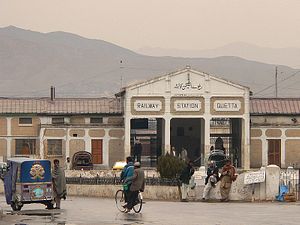Last week, Quetta city in Pakistan was yet again rocked by a terrorist attack that killed 61 police cadets. It’s the second deadliest attack in the same city in less than three months: An earlier attack killed more than 60 lawyers in August. While the attack highlights that Pakistan’s militant challenge is far from over, it also underscores that the country’s leadership does not take the rising security challenges seriously. The state has not just refused to accept that its counterterrorism strategy failed, but has also continued to woo various banned militant outfits that are a direct challenge to the state’s survival in the long run.
While security forces were busy containing militants in the targeted police academy, the government announced that the terrorists involved in the attack had received support from Afghanistan. This was another instance of the typical strategy of blaming foreign forces for terrorism in Pakistan, which is used by the country’s leadership to divert criticism and lure sympathetic public views for the sacrifices that Pakistan’s law enforcement agencies and people have made to fight the menace of terrorism. However, the reality in this regard is just the opposite: While there is no denying the sacrifices Pakistan has made in blood and otherwise to fight terrorism in the country, it’s equally concerning that despite these sacrifices, the Pakistani leadership continues to cling to its long-held policy of drawing lines between so-called good and bad terrorists.
Besides defining good and bad terror domains, the government has done little to clamp down on militant groups that it considers a threat to the country’s security. Rather, Pakistan’s political leadership, including the government, is attempting to woo various sectarian and other banned militant groups that, under Pakistan’s National Action Plan against terrorism, should be eliminated from the country. In recent weeks, the government has held meetings with different banned religious parties to enlist their support to contain Pakistan Tehreek–e–Insaaf (PTI)’s upcoming dharna (sit-in) in Islamabad. The PTI, on the other hand, has also approached various banned groups for their support against the government. Reportedly, the leadership of the Lal Masjid (Red Mosque), which has openly supported the Taliban and other militant groups, has also hinted at joining Imran Khan’s sit-in in Islamabad.
Even after the Quetta attack, a number of sectarian outfits continue to operate openly in Pakistan, while political gatherings and peaceful protests have been shut down by the government. In order to restrain PTI’s impending sit-in in the capital, the government days ago imposed Section 144 of the Code of Criminal Procedure, which meant that all demonstrations and processions in any public space in the city would be prohibited. Despite the imposition of Section 144, the Ahle Sunnat-Wal-Jamaat (ASWJ), a proscribed organization that has remained involved in inciting hatred against the country’s Shia Muslim population, was able to organize a gathering in Islamabad, with the capital police providing security while PTI workers were battling the police. Moreover, it is also important to note that the current ruling party, the Pakistan Muslim League-Nawaz (PML-N) has had several electoral adjustments with ASWJ, a party which had close relations with Lashkar-e-Jhangvi (LeJ), the group responsible for the Quetta attack, in the past. At one point, the former leader of the LeJ, Malik Ishaq, who was killed in a police encounter last year, also served as the vice president of ASWJ.
The military leadership’s priorities also appear to be on politicking rather than enforcing the NAP with full resolve. A week ago, the military termed a media report highlighting the details of a confrontation between the political and military leadership a “breach of national security” and forced the civilian government into firing its information minister. The military, however, has not called any high level meeting or explained why and how the Islamic State (ISIS) was able to carry out two devastating attacks in less than three months. The LeJ has for quite some time shown its willingness to join ISIS. The LeJ’s leadership is mainly based in the province of Punjab, but has also developed a presence in other areas.
The military leadership has repeatedly said that ISIS has no presence in the country. However, the resurgence of home grown militants that are willing to join Islamic State’s brand poses a far more serious threat than the Taliban for these groups are based all across the country with a significant support base at their disposal.
Amid all the political intrigue and bickering, five more Shia Muslims were gunned down in Karachi. Unfortunately, the sad reality in Pakistan is that banned outfits are allowed to stage public protests while political and civil communities are being shut down. The political spat that is shaping up in Islamabad has consumed the entire country and neither the political nor the military leadership appears to be worried about the rising challenge of sectarian violence in any serious way.

































